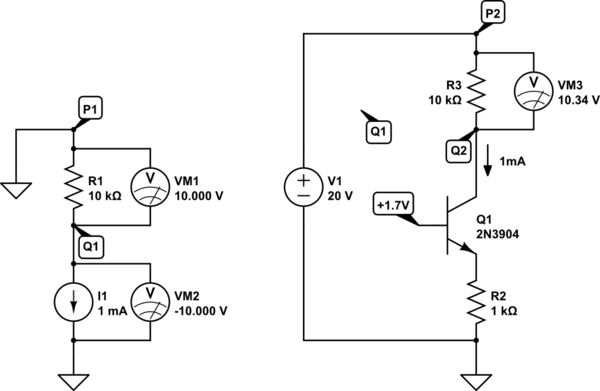In simulations, current sources are able to produce whatever voltage across them needed to have their rated current pass through them. That is, they are energy sources.
Transistors, and op-amps are not energy sources, and the best they can do is borrow energy from someone else, in order to produce some potential difference that will propel the expected current.
This is illustrated here (left), where I use a an artificial current source to obtain 1mA through resistor R1. You will notice that without any help, it's able to produce the exact potential difference across itself, which will in turn apply the necessary voltage across R1 (by KVL), to result in 1mA through the resistor:

simulate this circuit – Schematic created using CircuitLab
The important point about the circuit on the left, is that there are no other voltage sources present, and yet I1 is able to provide the necessary potential difference. That's because it's fake, a simulated element, and in simulations we can make any type of component we want. In real life, things are different.
If you are using transistors, op-amps or resistors to build a current source, none of which are able to produce a potential difference on their own, since they are not energy sources, you will need to provide them with a source of energy, whose potential they can use to modulate and regulate current through their load. That's what the circuit on the right is doing.
I use a transistor to set a fixed potential difference across R2 (about 1V here), as you have done in your own designs, but the transistor is not able to magically produce the potential difference across load R3 necessary for 1mA to flow there.
That energy must be provided by a separate voltage source, V1. The potential at Q can't become negative, as it did on the left, because the transistor can't produce any potential difference of it's own. Instead, what we do is make P much more positive, using a separate voltage source, and use the transistor to pass exactly the correct current necessary to "drag" potential Q down to exactly the right amount. The result is the same, 1mA through R3.
In other words, we can use a transistor to pass current produced by another voltage source, but we cannot make the transistor produce a potential difference all on its own. Instead of connecting the top ends of your loads to ground, 0V, there must be a higher potential there (P). Then the transistors can lower the potential at their bottom ends (Q), by becoming conductive, and passing current.






